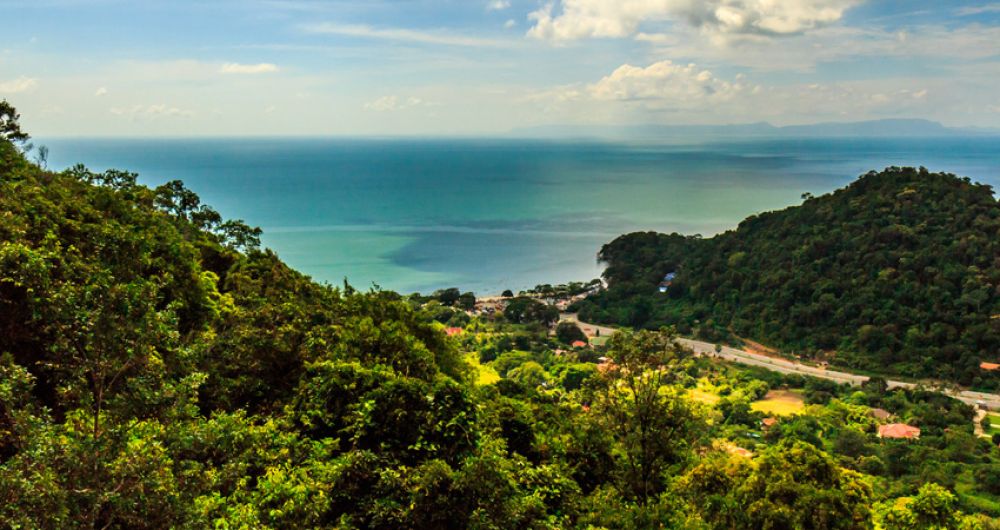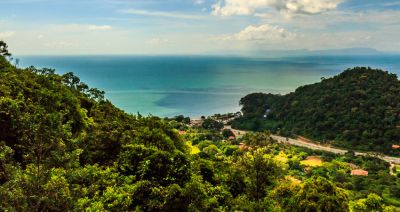

Kep National Park offers a remarkable trail hiking experience that allows visitors to immerse themselves in the lush greenery and diverse wildlife of Cambodia. The park, established in 1993, covers a significant area of the Kep Peninsula. Trails are well-marked and take hikers through a variety of terrains, including forested paths and rocky inclines, offering spectacular panoramic views of the sea and the surrounding landscapes. Along the way, hikers may encounter a range of flora and fauna endemic to the region. The main circuit is approximately 8 kilometers long, and several side trails provide opportunities to explore further. Hikers should bring water, sunscreen, and insect repellent, and wear appropriate shoes. The trek is suitable for most fitness levels, and trail maps are available at the entrance. Taking time to relax at a hilltop pagoda or watching the sunset from a viewing point are highlights of this activity.
Kep Beach, a small but picturesque crescent of sand, is the perfect locale for relaxation and sunbathing. While not as expansive as other Cambodian beaches, Kep Beach offers a tranquil retreat with a view of the nearby Rabbit Island. Visitors can spend their time lounging under the shade of tropical trees or taking a dip in the gentle waters of the Gulf of Thailand. The area is well-maintained and clean, boasting a serene atmosphere distinct from the more crowded tourist beaches. Several seafood restaurants and bars are located nearby, serving fresh local dishes and refreshing drinks. Vendors may also offer beach massages, adding to the relaxation experience. Kep Beach is an ideal spot for families, couples, and solo travelers to unwind and enjoy the natural beauty of Cambodia's coastline. Be sure to stay for the sunset, as Kep Beach is known for its stunning evening skies.
A short boat ride from Kep takes you to Koh Tonsay, popularly known as Rabbit Island. This idyllic island boasts pristine beaches and a laid-back atmosphere, offering a glimpse into the tranquil island life of Cambodia. Day-trippers can spend time swimming in the clear waters, snorkeling to observe the marine life, or simply relaxing on the white sandy beaches. Hammocks are available for rent, inviting visitors to enjoy the peaceful environment. The island also has modest bungalits for those who wish to stay overnight. Local restaurants serve up an array of seafood dishes. With no cars on the island and limited development, Rabbit Island is an excellent escape from the modern world. The boat trip provides scenic views of the coast and the chance to spot local fishermen at work.
The Kep Crab Market is a must-visit destination for seafood enthusiasts. Located close to the shoreline, this bustling market is famous for its fresh crabs, which are kept in floating baskets in the sea, ensuring they are as fresh as possible when served. Visitors can witness the lively bartering between vendors and locals, and have the unique opportunity to select their own crab, which will then be cooked to order at one of the many nearby restaurants. The market also offers an array of other fresh seafood options such as shrimp, squid, and fish. The experience is not just about the food; it's also about the vibrant culture and local way of life. Sampling the renowned Kampot pepper crab, which is cooked with the locally grown pepper, is highly recommended for a truly authentic culinary experience.
The Kep Butterfly Garden is a delightful escape that promises visitors a serene encounter with nature. Situated just a short distance from the Kep National Park, this enclosed garden is home to several species of local butterflies. It's a conservation effort that helps preserve and educate about these beautiful insects. As guests meander through the garden, they can observe various stages of the butterflies' life cycles, from eggs to full-grown adults fluttering around the vibrant flowers and plants. Informational signage provides insight into the species on display, and the peaceful ambiance makes it an excellent place for photography. The garden's layout is thoughtfully designed, with plenty of spots to sit and relax amid the fluttering butterflies and lush foliage. It is a family-friendly activity that combines education with the simple joy of being close to nature.
Exploring the fishing villages near Kep provides a fascinating glimpse into the daily life and culture of the local fishing communities. As you wander through the village, you'll see traditional stilt houses and observe villagers engaged in their daily routines, such as repairing nets, sorting the catch of the day, and preparing fish for drying. This immersive experience allows visitors to appreciate the simplicity and hard work of the local fisherfolk. It's an opportunity to learn about the traditional methods used in fishing and the way the community is built around this livelihood. Engaging with locals might also lead to discovering stories of the sea and the history of their village. Interaction with the community is encouraged, but it's important to approach with respect and sensitivity towards their way of life. Visitors usually find this activity to be a humbling and enriching cultural exchange.
Cycling is an excellent way to explore the picturesque countryside surrounding Kep. Bike rentals are readily available, and visitors can pedal through the scenic landscape at their own pace. The journey often includes riding through local villages, rice fields, and palm plantations, providing a close-up view of rural Cambodian life. Along the way, cyclists might encounter friendly locals, traditional wooden homes, and markets selling fresh produce. Stopping at one of the many pepper farms in the area offers insight into the cultivation of Kampot pepper, a famous product of the region. Cycling routes can vary in difficulty, but generally, they cater to a range of fitness levels. This activity allows for flexibility, as riders can choose to cycle for just a few hours or take a full-day tour to explore the region extensively.
Participating in a cooking class is a tasty way to experience Kep's culinary delights and learn about Khmer cuisine. These classes are typically hosted by local chefs or cooking schools and start with a visit to the market to select fresh ingredients. Participants will learn about unique spices and produce specific to Cambodian cooking. The class provides step-by-step instruction on preparing traditional dishes, which might include famous items such as Fish Amok, Beef Lok Lak, or the ever-popular Khmer Curry. A cooking class not only teaches you how to make delicious recipes but also offers insight into the role that food plays in Cambodian culture and family life. At the end of the class, you'll get to savor the fruits of your labor and share a meal with fellow cooking enthusiasts.
A tour of the nearby salt fields is a unique excursion that reveals an important aspect of Cambodia's agricultural practices. Visitors can observe the intricate process of salt farming and learn how workers harvest salt from the fields. This process generally includes flooding the fields with sea water, allowing the sun to evaporate the water, and then collecting the remnants of crystallized salt. The striking landscape of the white salt fields against the blue sky makes for an incredible visual experience. Tour guides explain the physical labor and techniques involved, providing a deeper understanding of the local economy and the significance of salt production in the region. Tours may include a visit to the production storage facilities, where the salt is processed for distribution. It's an educational and eye-opening activity, suitable for all ages.
After a day of adventure in Kep, a traditional Khmer massage is the perfect way to relax and rejuvenate. In Cambodia, massage is not just a luxury but a part of everyday health and well-being. Traditional Khmer massage involves deep tissue techniques and stretching without the use of oils, aimed at relieving tension and improving circulation. Spas and wellness centers in Kep may offer a variety of massages, from the traditional style to more contemporary treatments that incorporate aromatic oils and herbs. The serene settings typically feature a blend of natural materials and soft music, enhancing the overall soothing experience. Skilled therapists use their hands, elbows, and feet to apply pressure to the body, providing a holistic treatment that has been practiced in Cambodia for centuries.
